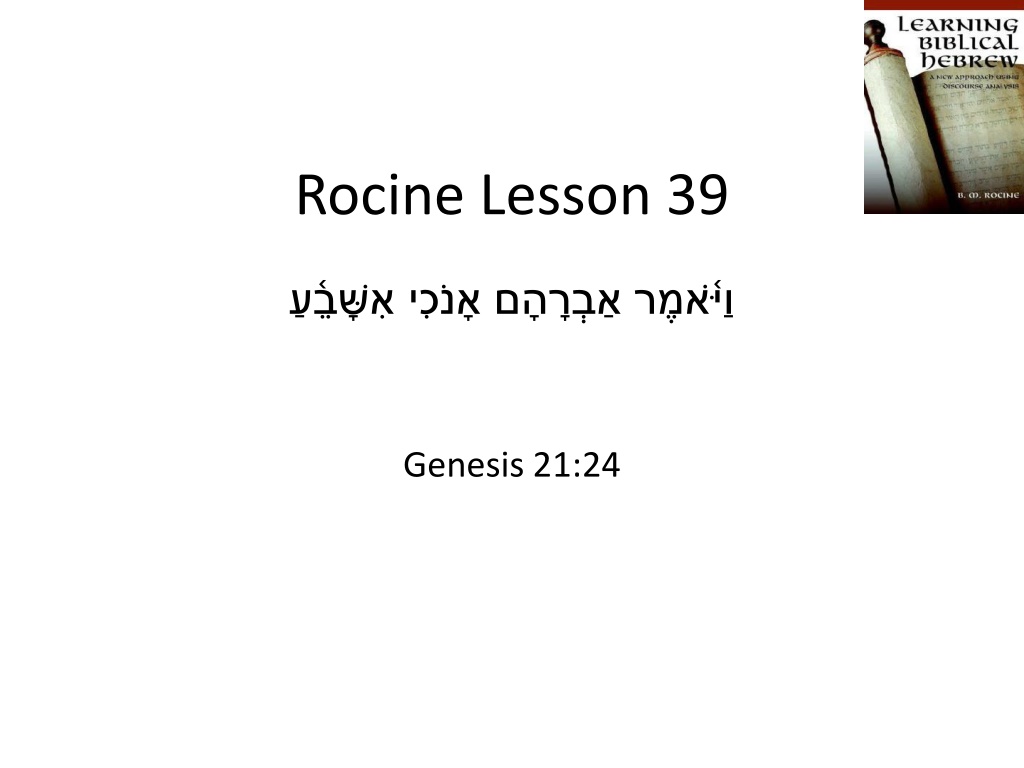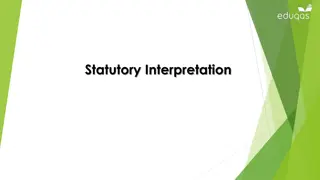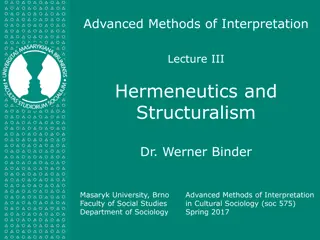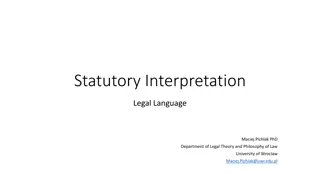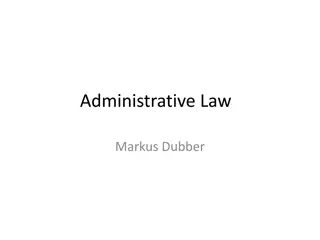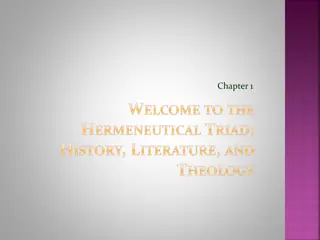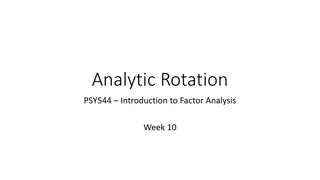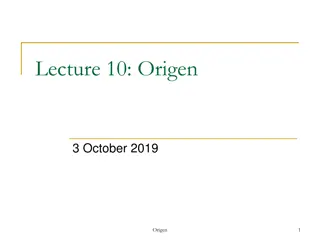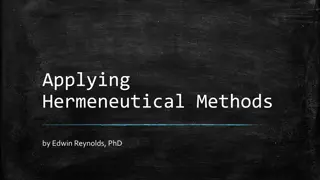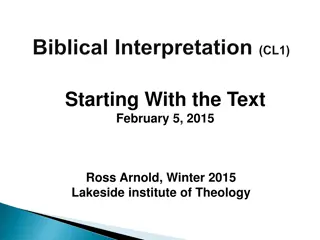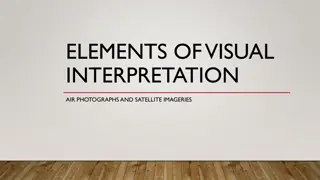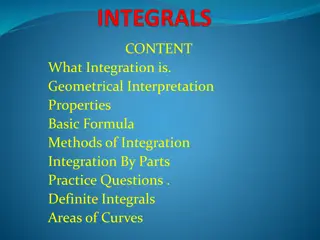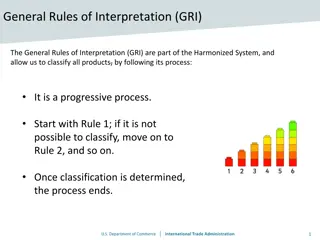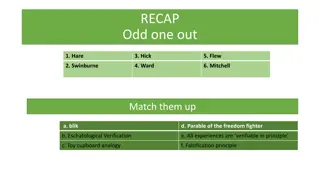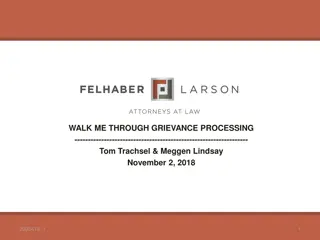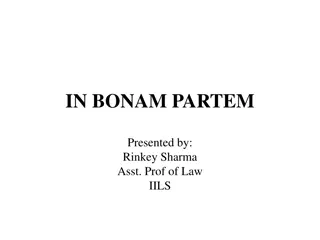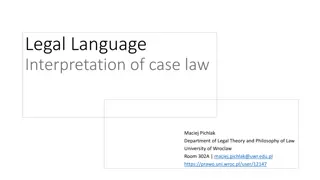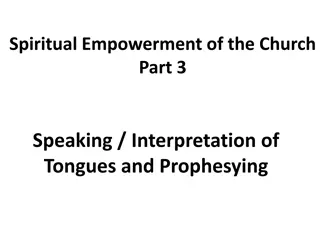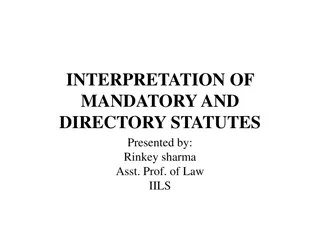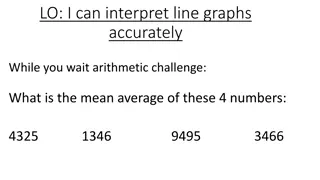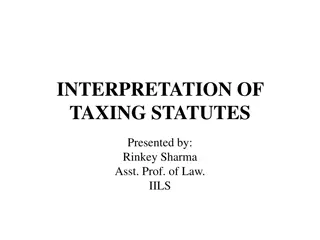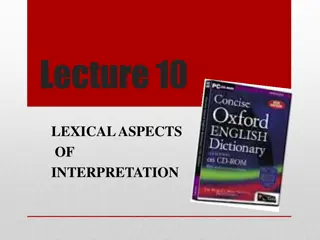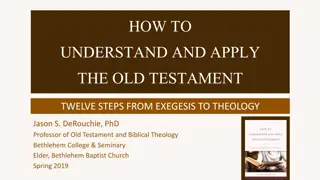Understanding Niphal Yiqtol: Analysis and Interpretation
Explore the intricacies of Niphal Yiqtol, focusing on identifying and reading the verb form. Delve into the presence of consonantal augments, dagesh variations, and assimilated Niphal Nun, providing insights into verb parsing and root meaning.
Download Presentation

Please find below an Image/Link to download the presentation.
The content on the website is provided AS IS for your information and personal use only. It may not be sold, licensed, or shared on other websites without obtaining consent from the author. Download presentation by click this link. If you encounter any issues during the download, it is possible that the publisher has removed the file from their server.
E N D
Presentation Transcript
Rocine Lesson 39 Genesis 21:24
Goals Identify and read the Niphal yiqtol
What we already know Translate the first 2 words.
What we already know Translate the first 2 words. Abraham said.
Niphal yiqtol Let s look at the second verb. Do we see any evidence of a consonant added to the root that we can t account for by some other means? (e.g. prefix, affix, prefix complement, inseparable preposition, pronominal suffix, etc.)
Niphal yiqtol Let s look at the second verb. Do we see any evidence of a consonant added to the root that we can t account for by some other means? (e.g. prefix, affix, prefix complement inseparable preposition, pronominal suffix, etc.) If we can, then we probably have an augment to the 3 root letters in our verb and therefore we have a stem/binyan other than Qal. Binyanim are built ( ) by adding consonantal augments to the basic Qal binyan.
Niphal yiqtol Let s look at the second verb. Where is the augment in this verb? Where is the augment in the Piel?
Niphal yiqtol Let s look at the second verb. Where is the augment in this verb? Where is the augment in the Piel? Dagesh in 1st root letter Dagesh in 2nd root letter
Niphal yiqtol Let s look at the second verb. Our verb is a Niphal and the dagesh is the assimilated Niphal Nun.
Niphal yiqtol Let s look at the second verb. The Niphal Nun assimilates in the yiqtol because when you add the yiqtol/wayyiqtol prefix, the Niphal Nun finds itself at the end of a closed syllable with no intervening vowel between it and the next consonant, and so it assimilates. - >
Niphal yiqtol Let s parse the verb. Root Stem Form PGN Function Root meaning
Niphal yiqtol Let s parse the verb. Root Stem Form PGN Function Root meaning X-yiqtol = Niphal Yiqtol 1cs To swear Topicalization (non-past)
Niphal yiqtol Note: In the strong verb we expect to see a segol as the 1cs prefix vowel. In the Niphal Yiqtol 1cs, sometimes it will be a segol and sometimes a hireq as above. E.g. Gen 21:4 I will swear Ezek 16:8 I swore Gen 4:14 I shall be hidden Lev 10:3 I will be sanctified
Niphal yiqtol So RULE: The sign of the Niphal yiqtol and wayyiqtol is a dagesh forte in the first root letter:
Niphal yiqtol So RULE: The sign of the Niphal yiqtol and wayyiqtol is a dagesh forte in the first root letter: But other things (like I-Nun verbs) can cause a dagesh forte to appear in the first root letter. We need a little more to identify a Niphal Yiqtol.
Niphal yiqtol There are 2 primary signs for the Niphal Yiqtol. Auditory Sign: i-a-ay sound hireq/qamets/tsere Visual Sign: The Niphal triangle at the front end hireq/dagesh/qamets See Animated Hebrew lecture 26 for details.
Niphal yiqtol There are 2 primary signs for the Niphal Yiqtol. Note that Piel yiqtol also has the i-a-ay sound but it will be shewa/patach/tsere and you ll have the dagesh forte in the 2nd, not 1st root letter. Compare: Piel Niphal Auditory Sign: i-a-ay sound hireq/qamets/tsere Visual Sign: The Niphal triangle at the front end hireq/dagesh/qamets See Animated Hebrew lecture 26 for details.
Niphal yiqtol (weak verbs) Why might the following weak verbs cause changes in the Niphal Yiqtol? I-Guttural I-Yod (I-Waw) I-Nun
Niphal yiqtol (weak verbs) Why might the following weak verbs cause changes in the Niphal Yiqtol? I-Guttural I-Yod (I-Waw) I-Nun What do you do with 2 nuns? What do you do because you can t double the guttural? How do you double the original waw? E.g. Very few hollow verbs have a Piel. has no Piel.
Niphal yiqtol (weak verbs) Why might the following weak verbs cause changes in the Niphal Yiqtol? I-Guttural I-Yod (I-Waw) I-Nun The Niphal Nun does not assimilate. The 1st root nun assimilates. Prefix vowel lengthens to tsere to compensate. Waw doubles as a consonant like in he commanded . That s not a shuruk, it s a double consonantal waw. Let s look at each of these.
Niphal Yiqtol I-Guttural I-Yod (I-Waw) I-Nun Strong 3ms 3fs 2ms 2fs 1cs 3mp 3fp 2mp 2fp 1cp
Niphal Yiqtol I-Guttural I-Yod (I-Waw) Hireq lengthens to compensate for lack of doubling in guttural. I-Nun Strong 3ms 3fs 2ms 2fs 1cs 3mp 3fp 2mp 2fp 1cp
Niphal Yiqtol I-Guttural I-Yod (I-Waw) I-Nun Strong 3ms 3fs In I-Yod (I-Waw) verbs we see the original waw in the Hiphil and Niphal. Here the waw doubles like in the strong verbs. We know the symbol is not the vowel sheruk because there is a qamets under it and you can t have 2 vowels in a row in Hebrew so this is the doubled consonantal waw. 2ms 2fs 1cs 3mp 3fp 2mp 2fp 1cp
Niphal Yiqtol I-Guttural I-Yod (I-Waw) I-Nun Strong 3ms The nun we see is the First Root Nun. The dagesh is the Niphal Nun. If we pull apart the elements it would look like this. 1. The Niphal Nun assimilates because it ends a closed syllable, i.e. there is no vowel between it and the 1st Root Nun. The shewa is silent. 2. The First Root Nun does NOT assimilate because there is a vowel between it and the tsade. 3fs 2ms 2fs 1cs 3mp 3fp 2mp 2fp 1cp
The Niphals reflexive sense As well as being the passive of the Qal, the Niphal can also have a reflexive sense. DEFINITION: When a verb is reflexive the subject of the verb receives the action of the verb as with other passive verbs. However, the subject of a reflexive verb is also the doer of the action. Reflexive action is therefore action done to oneself or in one s own interests. See Animated Hebrew lecture 25 for some finer distinctions in the Niphal, e.g. reciprocal, resultitive, middle, etc.
